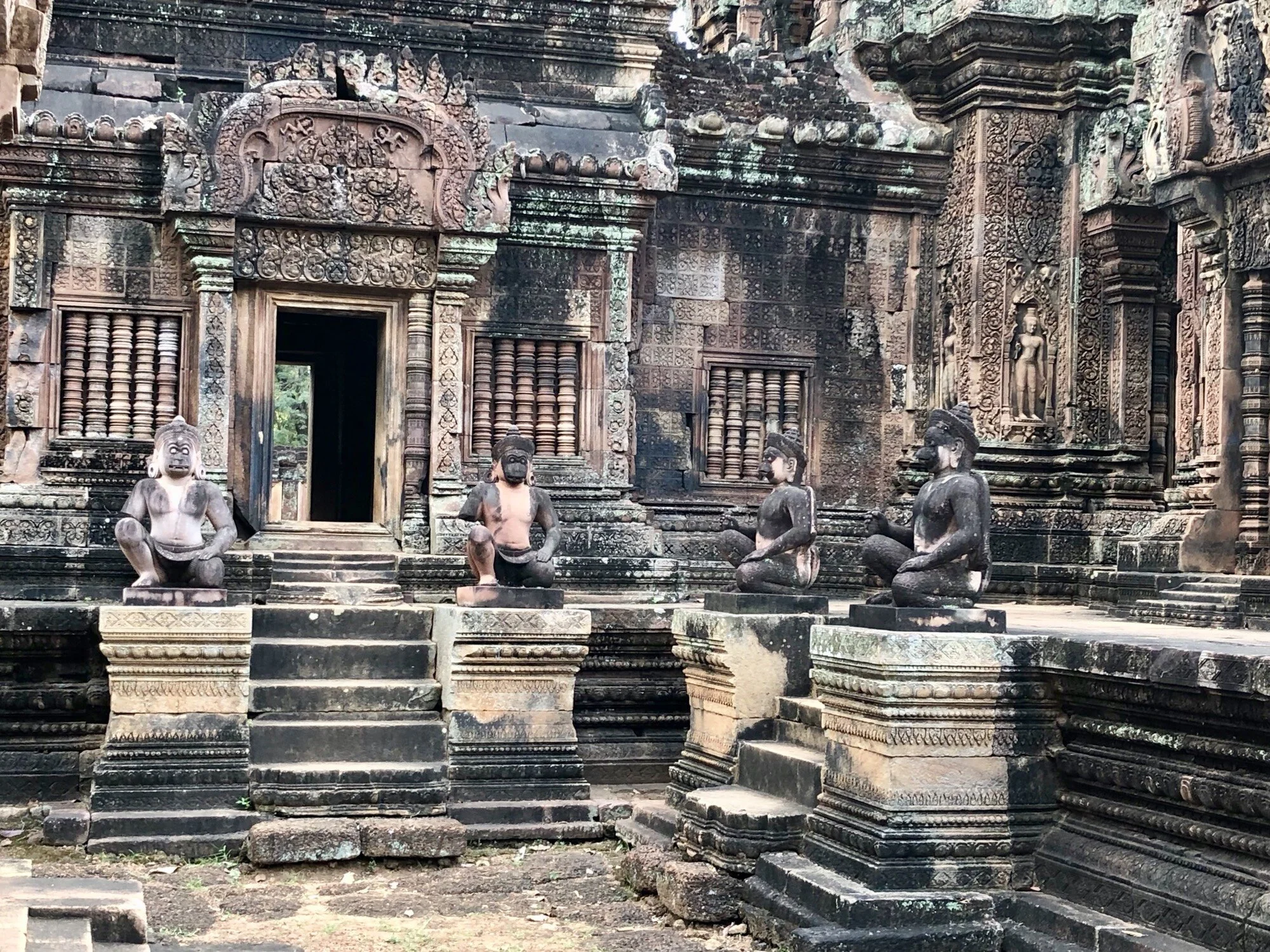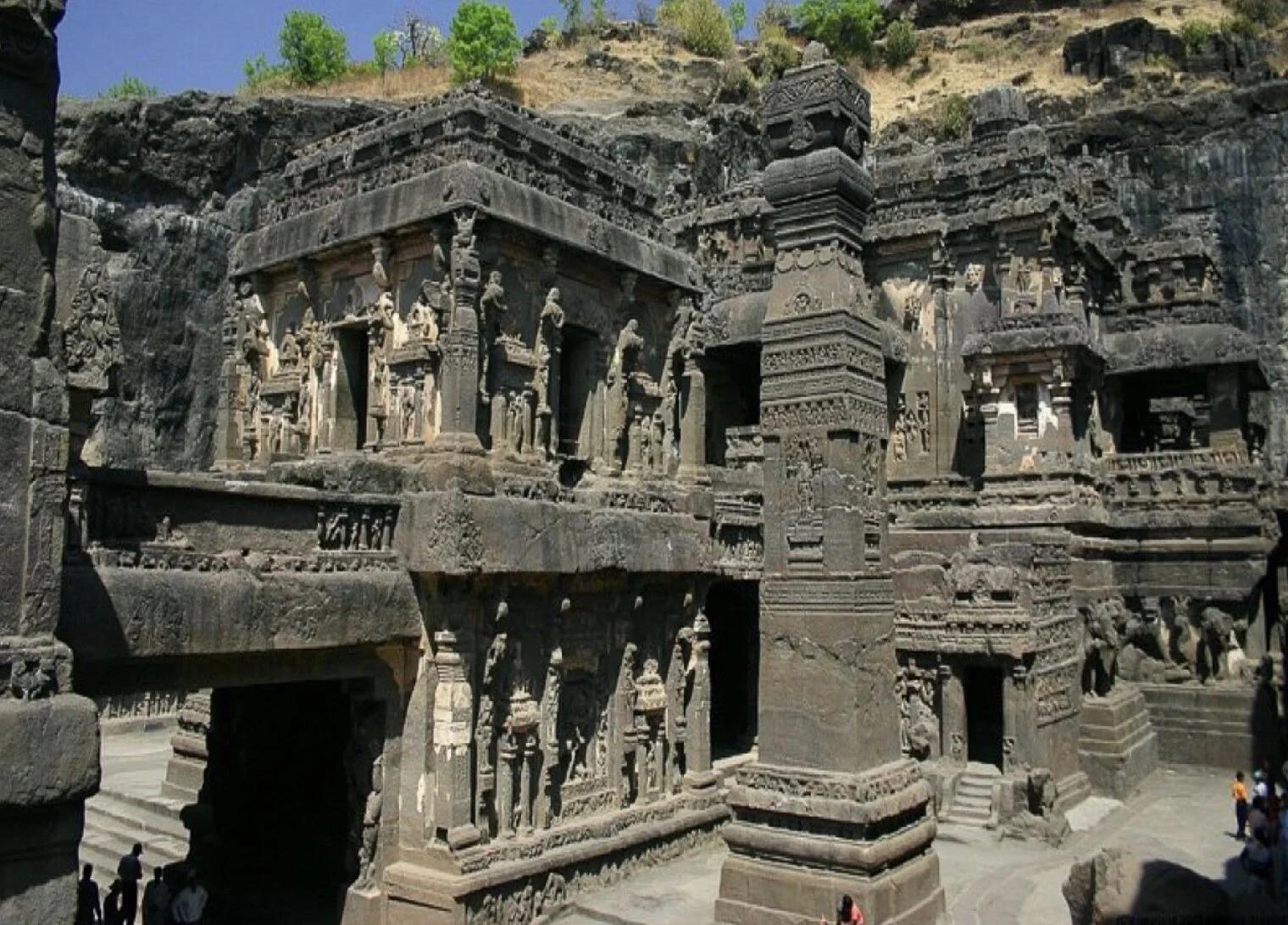What we see depends not only on what is before our eyes but also on what is within our minds. We notice only those things that we expect to see. God is everywhere, yet how is it that we do not see God anywhere? This is primarily because we do not expect to see God. What we need is to let go of expectations related to the world and embrace expectations related to God. Then we are on course to experience God’s presence right here, right now.
None of us has any idea when and how and in what form we will experience God’s presence. We just have to be prepared for anything—anything! Some of us may find “tongues in trees, books in running brooks, sermons in stones, and good in everything” (Shakespeare, As You Like It, 2.1). As to “sermons in stones,” imagine that you are visiting an ancient temple, built of granite stone. Perhaps you have already been inside such a temple. Even if you have not, you can still imagine that you are there at this moment.
You are standing before the altar, your heart is filled with love and devotion, and your mind is immersed in prayer. You look up and find yourself engulfed in a stream of golden light emerging from the sacred image on the altar. You shake your head, saying to yourself, “I’ve begun imagining things.” What you cannot dismiss as imagination is the peace and joy flooding your heart.
As you turn to go, you hear someone weeping. You look around and find that there is no one in the temple besides you. “Not another of my imaginations, I hope,” you say to yourself. You quickly realize that the sound of sobbing is real—and, incredibly, it seems to be coming from one of the steps at the entrance. Soon enough, you hear other sounds. It looks like some sort of conference is about to begin. You are baffled. You try to leave the place as quickly as you can, but your feet refuse to budge. Almost instinctively you go to a corner of the prayer hall and remain there, crouched, listening with bated breath to the unusual drama unfolding before you.
It is the bottommost step that is weeping. You hear other steps trying to pacify their weeping friend, but to no avail. Every piece of stone in the temple watches the scene helplessly. They are heard saying, “Hey, calm down,” “Look, tell us what’s bothering you. Why do you cry like this?” “We are here to help. Come, wipe those tears. Let’s talk.” The weeping stone looks up, pauses for a while, and says, “What shall I say, friends? You’re all well-placed now and I’m a nobody. I am simply weeping at my own fate. None of you need bother. Thanks for your support, but I’d rather be left alone.”
“Certainly not,” says the topmost stone in the central dome of the temple. “As the head of the granite community of this temple, it is my responsibility to see that every one under my charge is happy and contented. Tell us what your problem is.”
The step stone bows respectfully and says, “Since it is your order, brother, I shall obey, although I really don’t want to burden you all with my problems. It’s like this—I’ve been thinking for a long time. Do you remember the time we were all together on the Siruthamur hill? That was our home for centuries. There was no hierarchy amongst us. We were all equal, firmly united, and inseparably bound with love. That was the most memorable period of my life. Then, one fine morning, some people showed up and separated us from one another. Life was never the same for me again.”
The step stone sighs and continues: “Now what I’d like to know is this—what crime did my fellow steps and I commit that condemned us to a life of outcasts? Why should we be trampled upon by anybody and everybody? Look at that image, who was my neighbor at Siruthamur for as long as I can remember. Now she sits there smugly, hogging everyone’s attention and receiving all the worship. I don’t grudge her good fortune. My question is, don’t I deserve anything better than my present lot? Is all this fair? Isn’t there something called justice? Or all that talk of equality is just humbug?”
No sooner is the name of the image stone mentioned than everyone turns to look at the sanctum. There on the altar they see the always smiling, shining, kind-hearted image looking deeply concerned. “I want to say something if you’ll allow me,” she says softly.“Yes, yes, yes”—there is a chorus of approving sounds from every corner of the temple. They all adore the image stone for her holiness, wisdom, and her spirit of loving service. “She always speaks sense,” they say to one another.
“Dear sisters and brothers,” the image stone begins, “I remember distinctly the day I was separated from my close friend, who is now the bottommost step. It was early morning and the sculptor—his name was Ganapati Sthapati, if I remember right—came with his chisel and hammer. He first chose my friend to be made into an image. But my friend stoutly resisted. With every blow he received, he tightened his muscles and made his body almost impenetrable. After a while, the sculptor gave up. He told his assistant, ‘This stone is no good for the image. I think it’ll make a good step, however. Take it away and get it ready.’
“Then he turned to me and began his work. Skill and speed were evidently at his command. The blows I received were excruciatingly painful. They almost killed me—or so I foolishly thought at the time. But I had enough sense to simply absorb all the blows. I knew I was in good hands. So I just let go. While the sculptor continued his chipping and chiseling, I began meditating on my chosen deity (iṣṭa devatā), the Meru Mountain. When I opened my eyes exactly three days and three nights later, I was an entirely new person. A great change had taken place in me, not just externally but internally as well.
“Later, when I was installed ceremonially, I found that a new kind of energy had entered into my being, the energy of God. When people pray before me or offer me worship, I know that it is that divine energy within me that they are praying to and worshiping. Over the years I’ve gradually come to realize that the divine energy dwells not only in me but in everyone, even in brother step. All we have to do is simply manifest that energy, that’s all.”
“How were you able to manifest that energy of God?” asks a wall stone.
“Well,” the image stone says, “I believe that my submitting myself to be shaped into my present form without offering any resistance played a major part in my transformation. And that is where, I think, brother step went wrong. If he hadn’t resisted, he might well have been where I am today.”
A roof stone now speaks. Others consider her an intellectual because of the height at which she dwells. “I agree with what my sister image has said, but I would like to draw your attention to one important point. Submitting oneself to external forces and pressures can be beneficial—as it was in the case of sister image—if, and only if, the external agent is good, helpful and trustworthy. God is one such agent and that is why the devotees who come here and surrender to God attain fulfillment, freedom, perfection.
“But there are other not-so-good forces as well. Divine force belongs to a different category, but what about worldly forces? The blows given by the hammer and chisel of an experienced sculptor are good and beneficial, but not the blows we get when there is, say, an earthquake or a missile attack. At such times, we must tighten our muscles and resist with all our might. Yielding meekly at such times just won’t do. The mistake of our brother step was that he resisted at the wrong time and to a wrong person and the wisdom of our sister image was in surrendering at the right time and to the right person.”
All the stones nod their approval to the clarification offered by the roof stone. The central dome stone, who always chairs these conferences, listens with deep interest. Clearing his throat, he says, “You have identified the mistake of our brother step. Mistakes we all make. But what is made can also be unmade. Surely there must be some way out. You know well that we don’t believe in silly tales like eternal damnation.”
A young pillar stone now rises and says, “My feeling is that brother step hasn’t made any mistake at all, so the question of damnation, eternal or temporary, doesn’t arise. No one is designed to do everything. Every one of us has a different role to play and every role is important. The step is as important as the image or any of us. Our brother step may not be suited to be the image, but sister image is not suited to be a step either. If a floor stone decides to be a part of a pillar, she would be a disaster, and if I want to make my home on a dome, I would be a total misfit. We all have our own specialties, our strong points. Each is great in her or his own place.”
“I’ll second that,” says a stone from a wall of the music room at the northeastern corner of the prayer hall. “A temple is really music expressed in the form of stone, and we all have our notes to play. Every note is important. Even if one note were missing, the harmony would be destroyed. So we are all equally important. Hierarchy is a myth.” Then in a raised voice, he hollers, “Down with hierarchy-makers!”
“Hey, calm down. Don’t get so excited!” a group of elderly roof stones say smilingly to the music room stone and affectionately pat him on the head.
“Thanks for your support,” says the pillar stone to the music room stone. “I agree that sister image is the celebrity amongst us. She most certainly deserves the honor. We are proud of her. But that should not produce in any of us feelings of inferiority, jealousy, envy, or sorrow. We are all important—I keep repeating this because this is something we often forget. Every one of us is unique.
“Just consider this. If my fellow pillars and I don’t hold up this temple roof, where will everyone be, celebrity or not? If our roof stone friends don’t keep their positions firmly, how will the prayer hall be protected from rain and sunshine? If our brothers and sisters don’t do their job as steps, how will devotees enter the temple? If the floor stones don’t cooperate, how will the devotees sit and pray and meditate? And let’s not forget our friends down under, the foundation stones. If they didn’t stoically bear the weight of us all, we wouldn’t be here today.”
This impassioned speech draws a thunderous applause from the granite community. Chairman dome stone now speaks: “I forgot to mention that all the proceedings of this conference are being relayed through a specially installed hotline to our foundation stone brothers and sisters. It was not possible to make this arrangement in our earlier conferences, but this time we finally managed to do it. I’ve just now received a text-message from the head of the Foundation Stones’ Association. I’ll read out the message to you.”
Adjusting his glasses, the chairman now reads from the printout in his hands: “To the venerable chairman dome stone, we are grateful to you for setting up the hotline. We feel thrilled to hear the voices of our brothers and sisters after so many years. It’s been pretty dark and stuffy here below, but we are not complaining. We know that we are doing an important service that’s bringing joy and peace to thousands. And this awareness is bringing joy and peace to us as well. We are rushing this message to you in order to convey our gratitude to you all, and specially to brother pillar, for remembering us. May the Meru Mountain bless you all.”
The arch stone at the temple’s main entrance now rises to speak: “Friends, ever since I’ve occupied my present slot, I’ve been seeing these steps. Up until now I didn’t really know why they were so depressed. I tried to cheer them up whenever I could, but that was about all I could do because they never took me into confidence.
“Now that I know what the problem is, I would like to offer one suggestion. I humbly suggest that we stop looking at others for a while and focus on our own lives. Let’s stop comparing ourselves with someone else. Success is to be measured by how close we come to living up to our own potential. Let us work on that and forget the rest.”
There is a roar of approval from all the stones of the community. When the hubbub dies down, the arch stone continues: “Our brother step made a mistake, I think, in comparing his lot to sister image’s and to others’. If he had only been a bit more mindful and tried to live in the present moment without getting blinded by self-pity, he would have seen that before saluting the image most devotees first bow down to him as they enter the temple. It beats me how he didn’t notice this even once!”
A group of floor stones now speak in unison: “Ever since we heard that the dust of the devotees’ feet is the best medicine to cure the disease of worldliness, we have stopped grumbling. It is only our brother steps and we who have been given the rare privilege of bearing on our bodies this precious medicine.”
“Well said, well said!” the stones cheer joyfully. “Count your blessings, guys!” a roof stone shouts at the top of his voice. Everyone finds that they have a lot to be grateful for. They find also that every one of them serves a useful purpose. If they do their job faithfully and selflessly, and surrender the fruits of their karma at the feet of the Meru Mountain, they too can, like sister image, manifest the divinity within them.
The stones in the temple realize that equality does not mean uniformity. Their functions are different but not, on that account, superior or inferior to one another. Division of labor is good and unavoidable, they realize, but not the privileges that are demanded or are taken for granted. From the conference, another important lesson is learnt: there are situations in life when we must resist and there are situations when we must let go. Wisdom consists in knowing when to resist and when to let go, whom to oppose and whom to surrender.
Chairman dome stone raps his gavel and announces, “Folks, it’s time now for the prayer before we close.” There is silence at once and, led by the chairman, they all pray: “O Almighty Meru Mountain, you are our father, our mother, our friend, our brother, our sister, our everything. From you we emerge, in you we dwell, to you we shall return. You pervade the entire universe and you dwell in our hearts as well. Bless us, O Mountain of mountains, that we may realize our true nature, our true being, which is one with the absolute being that you are. ॐ tat sat, ॐ tat sat! May all the devotees who come to this temple attain peace. May all the people the world over attain peace. Śāntiḥ, śāntiḥ, śāntiḥ. Peace, Peace, Peace!”
Vivekananda words come to mind: “The one important thing in the attainment of spirituality is the attitude of the pupil. When the right attitude is there, illumination comes easily” (CW, 8. 106). Cultivating the right attitude is half the battle. If we are willing to be students, even stones can become our teachers. If we are willing to listen, we can hear them talk. Not only stones, but even plants and trees, fruits and flowers, streams and rivers, birds and beasts, all of these have a lot to teach us. But we can hear them only if we know how to shut up and listen.
An early version of this essay was written over 25 years ago, when a new temple was being constructed at Sri Ramakrishna Math in Chennai in southern India. The temple was dedicated in February 2000.




